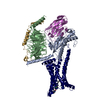[English] 日本語
 Yorodumi
Yorodumi- PDB-8inr: Cryo-EM structure of the alpha-MSH-bound human melanocortin recep... -
+ Open data
Open data
- Basic information
Basic information
| Entry | Database: PDB / ID: 8inr | ||||||||||||||||||||||||||||||||||||
|---|---|---|---|---|---|---|---|---|---|---|---|---|---|---|---|---|---|---|---|---|---|---|---|---|---|---|---|---|---|---|---|---|---|---|---|---|---|
| Title | Cryo-EM structure of the alpha-MSH-bound human melanocortin receptor 5 (MC5R)-Gs complex | ||||||||||||||||||||||||||||||||||||
 Components Components |
| ||||||||||||||||||||||||||||||||||||
 Keywords Keywords | MEMBRANE PROTEIN / human melanocortin receptor 5 / G protein-coupled receptor / ligand recpgnition | ||||||||||||||||||||||||||||||||||||
| Function / homology |  Function and homology information Function and homology informationmelanocortin receptor activity / Activation of G protein gated Potassium channels / G-protein activation / G beta:gamma signalling through PI3Kgamma / Prostacyclin signalling through prostacyclin receptor / G beta:gamma signalling through PLC beta / ADP signalling through P2Y purinoceptor 1 / Thromboxane signalling through TP receptor / Presynaptic function of Kainate receptors / G beta:gamma signalling through CDC42 ...melanocortin receptor activity / Activation of G protein gated Potassium channels / G-protein activation / G beta:gamma signalling through PI3Kgamma / Prostacyclin signalling through prostacyclin receptor / G beta:gamma signalling through PLC beta / ADP signalling through P2Y purinoceptor 1 / Thromboxane signalling through TP receptor / Presynaptic function of Kainate receptors / G beta:gamma signalling through CDC42 / Inhibition of voltage gated Ca2+ channels via Gbeta/gamma subunits / regulation of metabolic process / G alpha (12/13) signalling events / Glucagon-type ligand receptors / G beta:gamma signalling through BTK / ADP signalling through P2Y purinoceptor 12 / Adrenaline,noradrenaline inhibits insulin secretion / Cooperation of PDCL (PhLP1) and TRiC/CCT in G-protein beta folding / Ca2+ pathway / Thrombin signalling through proteinase activated receptors (PARs) / G alpha (z) signalling events / Extra-nuclear estrogen signaling / G alpha (s) signalling events / G alpha (q) signalling events / G alpha (i) signalling events / Glucagon-like Peptide-1 (GLP1) regulates insulin secretion / High laminar flow shear stress activates signaling by PIEZO1 and PECAM1:CDH5:KDR in endothelial cells / Vasopressin regulates renal water homeostasis via Aquaporins / hormone binding / PKA activation in glucagon signalling / developmental growth / hair follicle placode formation / G protein-coupled receptor signaling pathway, coupled to cyclic nucleotide second messenger / D1 dopamine receptor binding / intracellular transport / vascular endothelial cell response to laminar fluid shear stress / renal water homeostasis / activation of adenylate cyclase activity / adenylate cyclase inhibitor activity / Hedgehog 'off' state / positive regulation of protein localization to cell cortex / adenylate cyclase-activating adrenergic receptor signaling pathway / T cell migration / Adenylate cyclase inhibitory pathway / D2 dopamine receptor binding / response to prostaglandin E / adenylate cyclase regulator activity / G protein-coupled serotonin receptor binding / adenylate cyclase-inhibiting serotonin receptor signaling pathway / cellular response to glucagon stimulus / Transcriptional and post-translational regulation of MITF-M expression and activity / regulation of insulin secretion / cellular response to forskolin / regulation of mitotic spindle organization / Peptide ligand-binding receptors / viral budding from plasma membrane / adenylate cyclase activator activity / trans-Golgi network membrane / Regulation of insulin secretion / negative regulation of inflammatory response to antigenic stimulus / positive regulation of cholesterol biosynthetic process / negative regulation of insulin secretion / G protein-coupled receptor binding / bone development / response to peptide hormone / adenylate cyclase-inhibiting G protein-coupled receptor signaling pathway / platelet aggregation / adenylate cyclase-modulating G protein-coupled receptor signaling pathway / centriolar satellite / cognition / G-protein beta/gamma-subunit complex binding / adenylate cyclase-activating G protein-coupled receptor signaling pathway / Olfactory Signaling Pathway / Activation of the phototransduction cascade / G beta:gamma signalling through PLC beta / Presynaptic function of Kainate receptors / Thromboxane signalling through TP receptor / G protein-coupled acetylcholine receptor signaling pathway / Activation of G protein gated Potassium channels / Inhibition of voltage gated Ca2+ channels via Gbeta/gamma subunits / G-protein activation / Prostacyclin signalling through prostacyclin receptor / G beta:gamma signalling through CDC42 / Glucagon signaling in metabolic regulation / G beta:gamma signalling through BTK / Synthesis, secretion, and inactivation of Glucagon-like Peptide-1 (GLP-1) / ADP signalling through P2Y purinoceptor 12 / photoreceptor disc membrane / Sensory perception of sweet, bitter, and umami (glutamate) taste / Glucagon-type ligand receptors / Adrenaline,noradrenaline inhibits insulin secretion / GDP binding / Vasopressin regulates renal water homeostasis via Aquaporins / sensory perception of smell / Glucagon-like Peptide-1 (GLP1) regulates insulin secretion / G alpha (z) signalling events / cellular response to catecholamine stimulus / ADORA2B mediated anti-inflammatory cytokines production / ADP signalling through P2Y purinoceptor 1 / G beta:gamma signalling through PI3Kgamma Similarity search - Function | ||||||||||||||||||||||||||||||||||||
| Biological species |   Influenza A virus Influenza A virus Homo sapiens (human) Homo sapiens (human) synthetic construct (others) | ||||||||||||||||||||||||||||||||||||
| Method | ELECTRON MICROSCOPY / single particle reconstruction / cryo EM / Resolution: 2.73 Å | ||||||||||||||||||||||||||||||||||||
 Authors Authors | Feng, W.B. / Zhou, Q.T. / Chen, X.Y. / Dai, A.T. / Cai, X.Q. / Liu, X. / Zhao, F.H. / Chen, Y. / Ye, C.Y. / Xu, Y.N. ...Feng, W.B. / Zhou, Q.T. / Chen, X.Y. / Dai, A.T. / Cai, X.Q. / Liu, X. / Zhao, F.H. / Chen, Y. / Ye, C.Y. / Xu, Y.N. / Cong, Z.T. / Li, H. / Lin, S. / Yang, D.H. / Wang, M.W. | ||||||||||||||||||||||||||||||||||||
| Funding support |  China, 11items China, 11items
| ||||||||||||||||||||||||||||||||||||
 Citation Citation |  Journal: Cell Discov / Year: 2023 Journal: Cell Discov / Year: 2023Title: Structural insights into ligand recognition and subtype selectivity of the human melanocortin-3 and melanocortin-5 receptors. Authors: Wenbo Feng / Qingtong Zhou / Xianyue Chen / Antao Dai / Xiaoqing Cai / Xiao Liu / Fenghui Zhao / Yan Chen / Chenyu Ye / Yingna Xu / Zhaotong Cong / Hao Li / Shi Lin / Dehua Yang / Ming-Wei Wang /   Abstract: Members of the melanocortin receptor (MCR) family that recognize different melanocortin peptides mediate a broad spectrum of cellular processes including energy homeostasis, inflammation and skin ...Members of the melanocortin receptor (MCR) family that recognize different melanocortin peptides mediate a broad spectrum of cellular processes including energy homeostasis, inflammation and skin pigmentation through five MCR subtypes (MC1R-MC5R). The structural basis of subtype selectivity of the endogenous agonist γ-MSH and non-selectivity of agonist α-MSH remains elusive, as the two agonists are highly similar with a conserved HFRW motif. Here, we report three cryo-electron microscopy structures of MC3R-G in complex with γ-MSH and MC5R-G in the presence of α-MSH or a potent synthetic agonist PG-901. The structures reveal that α-MSH and γ-MSH adopt a "U-shape" conformation, penetrate into the wide-open orthosteric pocket and form massive common contacts with MCRs via the HFRW motif. The C-terminus of γ-MSH occupies an MC3R-specific complementary binding groove likely conferring subtype selectivity, whereas that of α-MSH distances itself from the receptor with neglectable contacts. PG-901 achieves the same potency as α-MSH with a shorter length by rebalancing the recognition site and mimicking the intra-peptide salt bridge in α-MSH by cyclization. Solid density confirmed the calcium ion binding in MC3R and MC5R, and the distinct modulation effects of divalent ions were demonstrated. Our results provide insights into ligand recognition and subtype selectivity among MCRs, and expand the knowledge of signal transduction among MCR family members. | ||||||||||||||||||||||||||||||||||||
| History |
|
- Structure visualization
Structure visualization
| Structure viewer | Molecule:  Molmil Molmil Jmol/JSmol Jmol/JSmol |
|---|
- Downloads & links
Downloads & links
- Download
Download
| PDBx/mmCIF format |  8inr.cif.gz 8inr.cif.gz | 184 KB | Display |  PDBx/mmCIF format PDBx/mmCIF format |
|---|---|---|---|---|
| PDB format |  pdb8inr.ent.gz pdb8inr.ent.gz | 135.9 KB | Display |  PDB format PDB format |
| PDBx/mmJSON format |  8inr.json.gz 8inr.json.gz | Tree view |  PDBx/mmJSON format PDBx/mmJSON format | |
| Others |  Other downloads Other downloads |
-Validation report
| Summary document |  8inr_validation.pdf.gz 8inr_validation.pdf.gz | 1.1 MB | Display |  wwPDB validaton report wwPDB validaton report |
|---|---|---|---|---|
| Full document |  8inr_full_validation.pdf.gz 8inr_full_validation.pdf.gz | 1.1 MB | Display | |
| Data in XML |  8inr_validation.xml.gz 8inr_validation.xml.gz | 40.9 KB | Display | |
| Data in CIF |  8inr_validation.cif.gz 8inr_validation.cif.gz | 60.7 KB | Display | |
| Arichive directory |  https://data.pdbj.org/pub/pdb/validation_reports/in/8inr https://data.pdbj.org/pub/pdb/validation_reports/in/8inr ftp://data.pdbj.org/pub/pdb/validation_reports/in/8inr ftp://data.pdbj.org/pub/pdb/validation_reports/in/8inr | HTTPS FTP |
-Related structure data
| Related structure data |  35601MC  8iocC  8iodC M: map data used to model this data C: citing same article ( |
|---|---|
| Similar structure data | Similarity search - Function & homology  F&H Search F&H Search |
- Links
Links
- Assembly
Assembly
| Deposited unit | 
|
|---|---|
| 1 |
|
- Components
Components
-Guanine nucleotide-binding protein ... , 3 types, 3 molecules ABG
| #3: Protein | Mass: 41879.465 Da / Num. of mol.: 1 Mutation: G49D,E50N,L63Y,ten deletions and A249D,S252D,L272D,I372A,V375I,G226A,A366S Source method: isolated from a genetically manipulated source Source: (gene. exp.)  Homo sapiens (human) / Gene: GNAI1, GNAS, GNAS1, GSP / Production host: Homo sapiens (human) / Gene: GNAI1, GNAS, GNAS1, GSP / Production host:  |
|---|---|
| #4: Protein | Mass: 40226.992 Da / Num. of mol.: 1 Source method: isolated from a genetically manipulated source Source: (gene. exp.)  Homo sapiens (human) / Gene: GNB1 / Production host: Homo sapiens (human) / Gene: GNB1 / Production host:  |
| #5: Protein | Mass: 7861.143 Da / Num. of mol.: 1 Source method: isolated from a genetically manipulated source Source: (gene. exp.)   |
-Protein / Protein/peptide / Non-polymers , 3 types, 3 molecules RL

| #1: Protein | Mass: 56920.516 Da / Num. of mol.: 1 Source method: isolated from a genetically manipulated source Source: (gene. exp.)  Influenza A virus (A/Victoria/3/1975(H3N2)), (gene. exp.) Influenza A virus (A/Victoria/3/1975(H3N2)), (gene. exp.)  Homo sapiens (human) Homo sapiens (human)Gene: HA, MC5R / Production host:  |
|---|---|
| #2: Protein/peptide | Mass: 1626.856 Da / Num. of mol.: 1 / Source method: obtained synthetically / Source: (synth.) synthetic construct (others) |
| #6: Chemical | ChemComp-CA / |
-Details
| Has ligand of interest | N |
|---|---|
| Has protein modification | Y |
-Experimental details
-Experiment
| Experiment | Method: ELECTRON MICROSCOPY |
|---|---|
| EM experiment | Aggregation state: PARTICLE / 3D reconstruction method: single particle reconstruction |
- Sample preparation
Sample preparation
| Component | Name: Cryo-EM structure of alpha-MSH-bound human melanocortin receptor 5 in complex with G protein Type: COMPLEX / Entity ID: #1-#5 / Source: MULTIPLE SOURCES |
|---|---|
| Source (natural) | Organism:  Homo sapiens (human) Homo sapiens (human) |
| Source (recombinant) | Organism:  |
| Buffer solution | pH: 7.4 |
| Specimen | Embedding applied: NO / Shadowing applied: NO / Staining applied: NO / Vitrification applied: YES |
| Vitrification | Cryogen name: ETHANE |
- Electron microscopy imaging
Electron microscopy imaging
| Experimental equipment |  Model: Titan Krios / Image courtesy: FEI Company |
|---|---|
| Microscopy | Model: FEI TITAN KRIOS |
| Electron gun | Electron source: OTHER / Accelerating voltage: 300 kV / Illumination mode: OTHER |
| Electron lens | Mode: BRIGHT FIELD / Nominal defocus max: 2200 nm / Nominal defocus min: 1200 nm |
| Image recording | Electron dose: 80 e/Å2 / Film or detector model: GATAN K3 (6k x 4k) |
- Processing
Processing
| CTF correction | Type: PHASE FLIPPING AND AMPLITUDE CORRECTION | ||||||||||||||||||||||||
|---|---|---|---|---|---|---|---|---|---|---|---|---|---|---|---|---|---|---|---|---|---|---|---|---|---|
| 3D reconstruction | Resolution: 2.73 Å / Resolution method: DIFFRACTION PATTERN/LAYERLINES / Num. of particles: 568095 / Symmetry type: POINT | ||||||||||||||||||||||||
| Refinement | Cross valid method: NONE Stereochemistry target values: GeoStd + Monomer Library + CDL v1.2 | ||||||||||||||||||||||||
| Displacement parameters | Biso mean: 58.72 Å2 | ||||||||||||||||||||||||
| Refine LS restraints |
|
 Movie
Movie Controller
Controller




 PDBj
PDBj




































